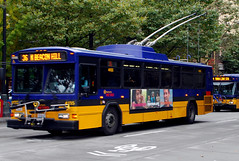 Trolleybus in Seattle. |
Trolleybuses are rubber-wheeled buses that are powered by overhead wires. They offer a number of advantages over regular buses, but are very rare in the United States.
There are currently only five US cities that operate trolleybuses. They are Boston, Philadelphia, San Francisco, Seattle, and Dayton. Trolleybuses are so rare because they require overhead wires, which are expensive to install, limit bus route flexibility, and are often considered ugly.
On the other hand, compared to normal diesel buses, trolleybuses are quieter, smoother, cleaner, and accelerate faster. They also offer a sense of permanence that normal buses can’t match.
Many of the advantages of trolleybuses come from their power source. Since they run on electricity rather than fossil fuels they emit no fumes, and they accelerate quickly, smoothly, and quietly. However, all those advantages can be duplicated by wire-free electric buses without the cost or trouble of overhead wires.
So why bother with wires?
Because the cost and relative rarity of wires is a sure signal that a transit route will be predictable and permanent. Wires provide the same sort of visual fortification that rail tracks provide. They are a clear signal to riders that they are dealing with a significant and special transit line.
Since so few trolleybuses have been built in recent years, and all the cities that use them have used them for decades, it is difficult to know how much of an effect wires without tracks can have on transit oriented development. Given the push for affordable BRT in many cities, the potential prospect of TOD-inducing buses is something that ought to be explored.
 Trolleybuses can shift lanes without disconnecting their wires. |
Trolleybuses even offer a significant advantage over rail streetcars. Since they aren’t tied to tracks, flexible trolley poles allow buses to switch lanes in order to go around obstructions. Without tracks to constrain them, trolleybuses mixing in a lane with cars are less likely to be held up by traffic. Additionally, many trolleybuses are built as hybrids and are capable of lowering their poles and running on batteries or fossil fuels as a backup.
It is unfortunate that the so few trolleybus systems survived the 20th Century. Most of them fell victim to the same transit death spiral that destroyed most American streetcar systems.
However, streetcars are enjoying a renaissance because contemporary planners have discovered they can be useful. It may be time for trolleybuses to enjoy a renaissance of their own.
November 14th, 2011 | Permalink
Tags: bus, transportation













